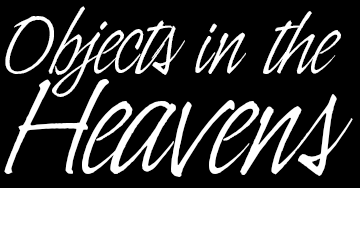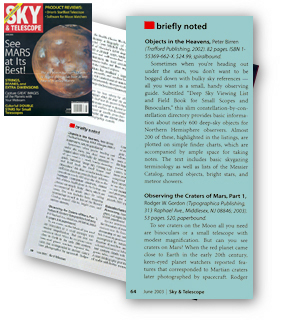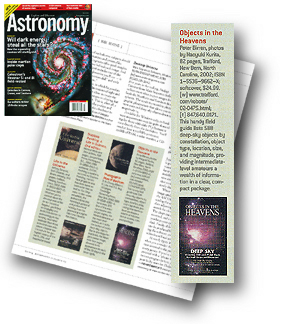



By: Alan Dyer
Every observer needs a good star atlas. But charts alone aren’t of much value in helping you decide what objects of the thousands plotted are worth looking at. Objects in the Heavens provides that essential guide.
Go to the full article.
• • • • • • • • • • • • • • • • • •

I wanted to share some good news about these books I recently came across. It’s just been a long time since I found a book, which is so useful, that I consider it a must have. Now these books have been out and available for quite a while, which makes it even more surprising that I’ve never come across them before.
by Al Milano (Go to the full article)
• • • • • • • • • • • • • • • • • •

Amongst the most impossible questions to answer at a star party is "What is the best telescope? Which one should I buy?" Of course the best answer to that imponderable is "The best telescope is the one that you'll use." Well.. the same thing goes for handbooks, manuals, and star charts. The right question to ask is "Am I going to use this?" And as regards Peter Birren's Objects in the Heavens, the answer is an unqualified YES
Robert Prokop, in his blog (read the full text here)
• • • • • • • • • • • • • • • • • •

"From my perspective the best beginner's field resource would have the following characteristics:
1. Covers all showcase objects of each category (stars, DSOs, etc.)
2. Provides sufficient graphical positional information to enable the observer to locate each object
3. Provides sufficient textual information to allow the observer to understand what to expect and to verify the observation
4. Because we've limited ourselves to "just one" for purposes of this discussion, is contained in a single, field-friendly volume."
Jim Barnett, on Cloudy Nights (read the full text here)
• • • • • • • • • • • • • • • • • •
I used this book out in the field for almost 2 years now and have been quite pleased with it. There have been quite a few nights that I have not prepared much of an observing plan and this book always comes to the rescue and provides targets for an evening full of observing. The real benefit of this book is it’s layout and amount of very useful information it’s provides in a compact form.
Mike Keefe, AstroNerd and Raleigh Astronomy Club (read the full text here)
• • • • • • • • • • • • • • • • • •

"...when you're heading out under the stars, you don't want to be bogged down with bulky sky references - all you want is a small, handy observing guide."
Sky&Telescope
"Sometimes, when you're heading out under the stars, you don't want to be bogged down with bulky sky references - all you want is a small, handy observing guide. Subtitled "Deep Sky Viewing List and Field Book for Small Scopes and Binoculars," this slim constellation-by-constellation directory provides basic information about nearly (750) deep-sky objects for Northern Hemisphere observers. Almost 200 of these (mag 7 or brighter) are specially highlighted, and ample space is provided for taking notes. The text includes basic skygazing terminology as well as lists of the Messier Catalog, named objects, bright stars, and meteor showers."
• • • • • • • • • • • • • • • • • •

Astronomy Magazine
"This handy field guide lists (750) deep-sky objects by constellation, object type, location, size, and magnitude, providing intermediate-level amateurs a wealth of information in a clear, concise package."
• • • • • • • • • • • • • • • • • •

and have no hesitation in recommending it, particularly to those who are just starting out in deep sky observing and/or have small telescopes or binoculars. I would certainly have appreciated this little book when I was starting out in deep sky observing in the early 1990's."
Faith Jordan, The Webb Society (read the full text here)
• • • • • • • • • • • • • • • • • •